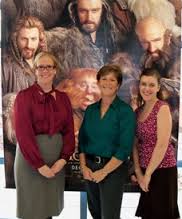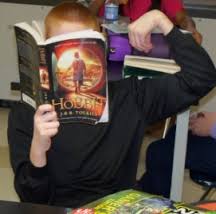In the spring of 2012, a group of English Language Arts educators from Franklin, MA, launched a highly successful middle school reading program around The Hunger Games.
In this five-part special series, the teachers who orchestrated the whole-school read will detail, step-by-step, this year’s initiative. Parts I and 2 focused on how the team made this year’s book selection, The Hobbit
, and encouraged student participation. In part 3, Mary Cotillo and Erin O’Leary discuss some of the challenges they’ve faced—and how they’re working as a team to overcome.

We know where we’re headed on this journey—we really do—and we know it’s going to be worth our while. How to get there? That’s another story.
Our merry band of literature lovers are much like Bilbo and the dwarves—prepared and peppy at the outset, tromping gamely through the Misty Mountains, blissfully unaware of the evils that are lurking around the bend.
If you are planning a school-wide reading program, please take a few moments to benefit from our experience as we highlight the pitfalls—both real and imagined—that line our path.
Challenge #1: Time
Although a read-a-thon may not seem like something that will dominate your life for several months, let us be the first to tell you: it can and it will.
We first hinted at our reading initiative in mid-October. We teased the reveal for about a week and made the surprise part of our journey. While we adults tend to get irritated when people (read: celebrities’ publicists) announce that they are going to make an upcoming announcement about an important announcement, our middle schoolers lapped it up.
After the reveal comes the reading. Not a big deal, right? Maybe not with a modern, popular young adult book with a glossy cover featuring knock-out models. But we’re not talking about heartbreakers; we’re talking about a furry-footed Hobbit. We needed to keep our initiative in the forefront of kids’ minds and capitalize on the tween desire to belong. Don’t get left behind! We peppered the school with propaganda, aired weekly videos encouraging reading, and ran daily “caught reading” contests. All of this takes
time.
Here’s how we created our schedule: We knew we wanted the kids to see the movie as close to the release as possible, which gave us the target date of Dec. 14 (before Christmas break—thank you, Peter Jackson!). Now, back up one week for those permission slips. If you want your students to have some level of accountability—a riddling or reaping or what have you—subtract at least one more week for that. That put us at a “due date” of December 3.
Which means our students had seven weeks to read
The Hobbit. Literally, seven weeks.
Of course, our read-a-thon will not end when we walk out of the theater. The field trip is what requires the most planning and generates the most excitement among the kids, but we also rock some post-viewing school-wide events. In fact, we decided to save most of the activities for after the movie. It gives us some time to regroup, and also gives our little hobbits the chance to reconsider and join the throng. Last year we picked up an additional thirty-something tributes after the movie. Apparently, they didn’t know how cool we were.
Challenge #2: Faculty Support
Like any initiative, if your school is like ours, you’ll have reactions ranging from immediate “This is awesome! What can I do to help?” buy-in to “You’ve got to be kidding me, I can’t handle one more thing before Christmas” resistance.
If your budget allows, order copies of the book for your teachers. Make them signs for their classrooms, offer lessons, news stories, and articles, and provide logistical updates for your faculty as you are able. It’s not always easy, but don’t stress too much. Most are only concerned if an event interferes with their teaching day. If you can provide advance warning, most will happily accommodate.
However, there are some teachers who’ll be armed with a laundry list of questions, and you won’t always have answers. (See “Doubts” below.) Learning styles are evident even among adults. Some need to see the “big picture,” while others crave minutia, playing the “what if?” game. If you’re concerned with collegial dynamics, have the important stuff come from above. That’s what Gandalf is for. Remain as positive and kind as humanly possible; if your faculty isn’t excited about your initiative, the kids will suffer.
Overall, we’ve been blessed with incredible support that far outweighs any stray negativity that comes our way. We have more offers for support (and requests to chaperone) than we can possibly accept. We’ve found teachers are more than willing to tolerate disruptions to their schedule in exchange for the unifying effects of a school-wide adventure.
Challenge #3: (Self) Doubts
An adventurer’s greatest enemy is not a goblin or a giant spider or a dragon, but oneself. We intrepid few who willingly embark on such grand missions must be prepared to come face to face with our own doubts and fears. And, as was so beautifully illustrated to the Horace Mann Middle School contingent recently, we must be willing to stay the course.
The Hobbit is not
The Hunger Games. Last year we had students falling over themselves to participate. This year, the readers are much more reluctant. The book is long. It has old-fashioned language. There are no mutts or fireballs or love interests. It wasn’t long before we faced what Mary at least considered to be a disastrous realization: we were highly unlikely to fill six buses.
“But we
have to fill six buses,” the doubting voice in Mary’s head cried. “We have a mandate! We have a precedent! If we don’t meet these new, higher expectations, what will happen next year? We’ll lose our budget! We’ll have to fight tooth and nail for support just like we did last year. Not filling six buses is
not an option! We need to change the program!”
So we did…almost.

First, we did some research to figure out where the first movie ends (
The Hobbit film adaptation will be a trilogy) and figured that students would have to read roughly five chapters to understand the first movie. We talked about eliminating the requirement to read the book, opening up the field trip to those students who had read at least the first five chapters. This would encourage those students who were stymied by difficult language, bolster our numbers, and ensure our literacy initiative would be funded in years to come.
Oh, and the message the kids would receive about not having to read the whole book? The lowering of our standards? We’ll just ignore those issues for now. We’ve got six buses to fill, people!
Thank goodness, once again, for coolheaded administration. When we approached our Gandalf with our worries and suggested plan of action, we were quickly set straight. It mattered not if we had 50 or 500 students participating; our program (and budget!) was safe. We were reminded to keep our eye on the
real prize. We are in this not for movie premieres, not for newspaper coverage, but for the kids. We are encouraging a love of reading and literature, and to do that we absolutely must require the students to read the whole novel.
And as for Mary’s worries that we’d only have a handful of kids participate? That was proven wrong on the day before Thanksgiving break, when we held a surprise early-riddling. Twenty-five students qualified in an hour. Not too shabby!
Mary Cotillo and Erin O’Leary both teach English Language Arts at Horace Mann Middle School in Franklin, MA.
Read the rest of the series here:
Six Buses: The Quest for School-Wide Reading Begins!
The Quest, Part 2: Monday Morning Hobbit-Backing
The Quest, Part 4: Some Shall Not Pass
The Quest, Part 5: The Journey Pays Off in Unexpected Ways